
|
Opening Statement –
While studying Strategies of ‘Global Conservation Education’ at the Conservation Education Center of Muskoka Woods, Ontario, Canada, during the year 2018, I came across some very pertinent and important questions which were raised by fellow educators, experts, researchers and policymakers - Who owns Biodiversity? Whose job it is to protect Biodiversity? Who takes the ownership of protecting the species? - Scientifically inclined people who are doing research in various fields? The Communities which are experiencing Human-Animal conflicts more often? or does Biodiversity also belong to the general public, the normal citizens, who have an equally important role to play when it comes to conservation? People like me, 'non-experts', who strive to do something for the environment by self-study, self-participation in related workshops, seminars and training programmes, often face the above questions. So, whom does 'biodiversity' actually belong to? As WHO puts it - Biodiversity underpins life on Earth, and refers to the variety found in biota from genetic makeup of plants and animals that are also related directly or indirectly to 'cultural diversity'. The Cultural Diversity is actually associated with the Local Communities, some of which are directly dependent on the Biodiversity of the different regions where they thrive. Expressing my observation - In India, Over 3000 Gram Panchayats, Local Institutions and Community Representatives submitted resolutions to the PM demanding ‘Community Centric Legislation' on Biodiversity, a few years back. Panchayats, Local Institutions and Community Representatives, and local institutions from the States of Tamil Nadu, Andhra Pradesh, Uttar Pradesh, Orissa and Meghalaya have submitted over 3000 Resolutions to the Prime Minister, till date. I do not have concrete data about Assam though, but I am sure some resolutions have been sent by some communities and local bodies, either directly or through some supporting Non-Government Organizations, over the past years. ‘They’ have expressed serious concern about the developments relating to India’s Biodiversity legislation, and in particular the Biodiversity Rules of 2004 and the ongoing attempts by State Governments to implement these. Though the Act itself describes the communities as “conserver and preservers” of biodiversity, the Rules delineating the provisions of the Act actually limit the power and function of the very same communities to only documentation of their resources and knowledge, with no legal provision to exercise control over what is documented and take appropriate actions. Thus, some communities like the Ghora Abhe Society of Arunachal Pradesh and the Garo Communities of places like Rajakhumai in Assam-Meghalaya border areas have taken the preservation into their own hands, inspired and supported by some NGOs and other patrons. The designation of Biodiversity enriched areas in Meghalaya as the 'Sacred Groves' by the local communities, are examples of such practices. India’s biodiversity is severely threatened; habitats, wildlife populations, traditional cultures, geological cycles, and a range of other attributes are being destroyed. There are a variety of reasons for this, including increasing exploitation of biological resources for trade both at National and International levels. India enacted a Biological Diversity Act in 2002 in pursuance with its obligation to the Convention on Biological Diversity. The Biological Diversity Act 2002 is a law meant to achieve three main objectives: • the conservation of biodiversity • the sustainable use of biological resources • equity in sharing benefits from such use of resources Somewhere, I strongly feel that the management principles failed to recognize the expertise of the ‘grassroot’ – the people of the forests and from the villages living in fringe areas of the forests. I myself have travelled and interacted with such ‘local experts’ in the States of Assam, Meghalaya and Arunachal Pradesh and have come across people with remarkable knowledge and understanding of Biodiversity, sustainable use of the Forest Resources and also Conservation. This knowledge pool is the actual capital of the local Biodiversity Management Committees. The Act had received mixed responses; as it did contain some progressive provisions towards ensuring community control over Biodiversity. However, the issuance of the Biological Diversity Rules 2004 reduced the role of the Biodiversity Management Committees to be established at village levels to being mere 'data providers'. The Actions were somewhat restricted.  SH. Rajik Tachang, a veteran member of the Ghora Abhe Society of Arunachal Pradesh can identify over 500 species of Medicinal and Edible Plants, their proper use, growth patterns, diseases, cure and tells amazing stories about sustainable use of Forest Resources and Conservation of Species carried out by 5 generations of his family.  SH. Rajik Tachang, interacts with the student participants of a Conservation Education Programme organized by WildRoots-India, during the year 2017. The Act had received severe response and criticism from different factions of the civil society and community representatives as they felt that such Rules would simply place a vast mass of people all over the country, mainly tribals, farming communities, indigenous people, fisherfolk, pastoralists etc. at the mercy of a Centralized or State Level System of the management of biodiversity through the National Biodiversity Authority at Chennai and State Biodiversity Boards at the State levels. The NBA oversees access to biological resources (wild plants and animals, crops, medicinal plants, livestock, etc), their commercial utilization, transfer of rights of research, and intellectual property rights related to biodiversity. Foreign institutions and companies are required to seek approval of the NBA for access whereas Indian companies or institutions are required only to intimate the NBA of their bio resource usage, thereby placing an unjustified trust in Indian corporates and institutions, knowing Indians (especially industrial corporations) are not necessarily any more responsible towards the environment or towards local communities, also some Indian companies could just be local fronts for foreign enterprises. Nowhere in this figures the role of the communities whose lives are entwined with biodiversity around them, be it through culture, religion or for basic sustenance - The people who face human-animal conflicts every day, particularly the communities who live near the forest fringes. What it is critical to note is that most of NBA's work seems to be on processing applications for access to biodiversity and/or research work. There is little attention to the conservation and sustainable use of provisions of the Act. The panchayats or some Indian States came together for the second time as part of the Campaign for Community Control over Biodiversity and sent their resolutions to the Prime Minister, during the year 2007. Several panchayats from all across the country had previously sent resolutions to the Union Minister of Environment and Forests in 2004, soon after the Biological Diversity Rules were enacted. Representatives had also met the Minister and submitted a memorandum in December 2004. However, no action was taken. Panchayats have come together again, multiple times and this time have sent resolutions to the Prime Minister clearly stating they will not cooperate in any of the activities of either the NBA or the State Biodiversity Boards (SBBs) unless the following principles are recognized: 1. Control over all aspects of local biodiversity and related knowledge must be with the local communities, with government departments helping us to tackle the threats that these face from destructive development and commercial forces. They have also stated 2. Our knowledge is our heritage and not for sale. Therefore we shall not be compelled into any process that reduces it to a tradable commodity which can be privatized. (Privatization of Biodiversity Conservation is an entirely different ball game, and needs to be addressed separately). 3. Documentation of local resources and traditional know-how ought to be voluntary in any form and manner as the community decides, and needs to be legally protected against misuse by outsiders. NBA, SBBs and all relevant government institutions must recognize existing social formations and customary groups that are the real biodiversity managers, and empower Gram Sabhas or village councils to decide on whether or not to set up new Biodiversity Management Committees (BMCs). I came across some of these BMCs in places like Sohra - Cherrapunjee in Meghalaya, Williamnagar in Tura, Meghalaya, Bhetnai in Odissa and Pakke in Arunachal Pradesh. Readers might wonder how I came across such info. Well, it is only the Educational and Community Interaction Programmes which we have been organizing over the past 5 years, which have actually given us opportunities to interact with the Local Communities, bodies, BMCs and know more about their operational strategies. A lot can be learnt when a person travels and has the interest to know more, in spite of having any prior expertise. It is the true essence of PPSR – Public Participation in Scientific Research, or more easily put – ‘Citizen Science’.  Tinsek D Sera, from Karbi Anglong shares her knowledge with her Daughter in Law and our International Community Interaction participant from Spain.  Everyday Tinsek collects edible plants from the Forest to feed her family, and has extensive knowledge about the Flora & Fauna, which would fascinate even scientists. In a nutshell - (as we have learnt!) Local people’s access to biodiversity and its benefits, and the sharing of these benefits amongst local communities, must be given priority over and above commercial trade; and they shall allow neither misuse by corporates nor appropriation by governments. Biodiversity Conservation and Preservation needs to be a responsibility of the Local Communities. Some community supported organizations from Andhra Pradesh have been one of the earliest to demand a change in those provisions of India's Biodiversity Act that marginalize local bodies such as Panchayat. It had facilitated several meetings of Sarpanchas from AP, Assam, Meghalaya, Arunachal Pradesh and other states to explain the implications of the Biodiversity Act. I know that this short essay would spark many discussions, for that is what I am exactly looking forward to. Expressions are welcome, as we have embarked on a never-ending journey of knowledge and observation, and would be needed the collaboration, cooperation of our well-wishers, friends and patrons. - An Observation and Study based short essay compiled by - Biswajit De, Founder President, WildRoots - India. |
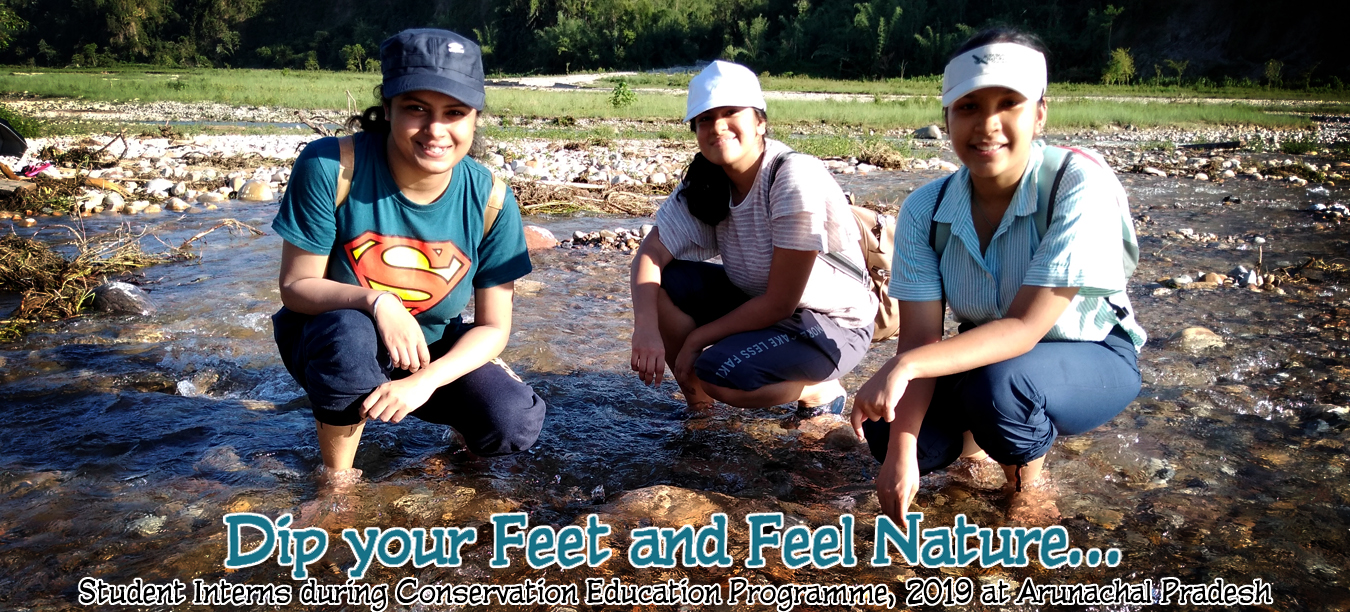
An idea that germinated in our minds took form of a marvellous journey that we undertook to Jowai recently. Among endless discussions and deliberations a date was fixed. Along with our respective families and a travel loving uncle of ours we started for Jowai. Since, it was the weekend; the route to Barapani was choc a bloc with cars going to Shillong and Sohra. We took the diversion near Barapani & from there onwards the road was silky smooth with clouds hanging over the edges. With every blink of our eye, we would unmistakeably see a slice of heaven, or whatever the definition of heaven might mean for anyone. Virgin unexplored beauty is what you can expect to see in Jowai. The journey in itself filled us with ecstasy and we wondered what the destination could do to us.
 The drive to our guest house was a mesmerizing one and after freshening up we considered exploring a waterfall which was proximate to our guest house. The Tyrshi falls is one of the least explored waterfall in Jowai. 5kms from jowai town, this falls, with milky white water comfortably pouring its pathway into a vertical drop installed in us an immediate calming effect. The falls overlooked a valley below ,which resembled an exact dreamy painting. We then proceeded to the Nartiang Village, famous for its monoliths erected in memory of the erstwhile Jaintia rulers of the 17thcentury. The monoliths silently spoke of the dauntless warriors and their sacrifices. It very much surprised us to learn that it homed one of the tallest and biggest of the monoliths named Moo Iong Syiem which is about eight mts in height, 2 m in breadth and 0.46 m in thickness. It was erected by U mar Phalyngki, a trusted lieutenant of the Jaintia kings.   When finally returning to our guest house, we were welcomed by a steady drizzle. All I knew was to come out of the comforts of my room and feel what the moment wanted me to feel. Pure enigma flooded me. I wanted to capture the sunrise in my camera so I had set the alarm for 4 in the morning next day. As if Jowai had not already stupefied me enough with her enchantments, the next day was again another blessing. What I witnessed at dawn was simply a concoction of elements that would surpass all human bliss. The powerful sunburst, the fairytale clouds, the ghostly hills, the silhouette of it all finds a magical way to rid one clean of any doldrums that we as humans often get trapped into. The subtlety of the winds, the harmony of nature, the concord of it all is what you would expect in Jowai. I had become a flightless bird for a while but it seems like Jowai had restored back my wings and now I’m ready to fly. - Sanjita Dutta |
 | About Sanjita in her own words…
"I am a freelance writer, photographer and an entrepreneur from Guwahati, Assam. I mostly love to immerse myself in the world of books, tea, music and good food. Travel, photography and writing forms my Holy Trinity... " |
|
It was the year 2010. My parents planned a trip to the Forests of ‘Dooars’ during the month of October. I was very much excited about the trip because it was the first time I was going to visit a forest. Being a kid, I expected to see all the animals residing in the forest, but those notions were destroyed after the forest safaris, where I could only see some deers and two elephants. But I could not see any leopard or rhino. So, my father, after my prolonged nagging, decided to take me to Khairbari Leopard Rescue Center.
It seemed like a natural forest to me and not like any other rescue center with cages and confined spaces. I loved the place so much. We were given a battery car, which had the capability to accommodate 8 people. We were literally locked inside the car (most interesting part). And as we entered the rescue center, I concluded one thing - that the most beautiful thing about the place was the fact that it was a place where the leopards were roaming around freely and we were the ones, ‘caged’. The area was not less than any natural habitat. As the journey progressed, we saw that the forest area started getting denser. We were also given a guide, who said that the injured leopards are brought in here and proper treatment is provided after which they are released back in the forests. As a kid, I questioned, "But this is also a forest! Then why are the leopards taken to another forest, again? ". So, our guide said that it was like a hospital of the leopards and that - they try not to put them in the cages and make it a HOME away from their homes. I loved the concept so much. This is exactly how WildLife rescue centers in India should be. Some of them are really in a bad shape. During the safari, we saw two leopards. One of them, I had a chance to capture with the help of my camera, and of course with my father's help (since, I was a kid, back then). 
This is a rehabilitation center for tigers and leopards nestled in South Khairbari forest. One can visit the place either from Jaldapara or while approaching Jaldapara from Murti via Birpara. From Jaldapara Tourist Lodge (also known as Madarihat Tourist Lodge) of West Bengal Tourism, a drive of about 2kms will get you to the entrance of South Khairbari forest. From there you need to drive for another 12kms through dense forests. In 2005 when a ban was imposed on animal shows in circus, the forest officers seized some 11 tigers from Olympic Circus in Hoogly district. Those tigers were later brought here for rehabilitation. But those tigers have died of aging. This center was inaugurated on November 5, 2005 by then minister in-charge of forest. It was then named as 'South Khairbari Circus Animal Rescue Centre'. Nowadays the tigers that are wounded, or found unwell or seized from the smugglers, as well as leopards and their solitary cubs found in the tea gardens are brought into this center for rehabilitation. Since the animals are kept somewhat in natural habitat although in enclosures, it may not be always easy to spot them unless they are out in the open and visible. I enjoyed the entire car ride, very much. I loved the forested recue center a lot! I loved the concept of making the rehabilitation center a HOME and I would really recommend all of my friends and relatives to visit the place and to support it through small donations. Places like these are often ignored, but they play a very important role in Wild Life rehabilitation.  |
‘Our planet’s increasingly interdependent human and ecological systems has crushed many natural habitats, but also continues to threaten the survival of millions more’ – Just a Quote!
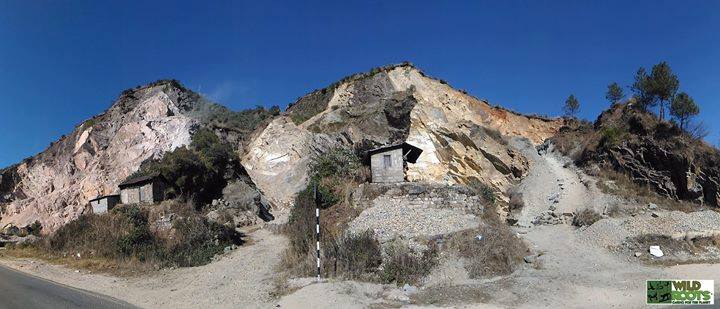 The Hills are being Cut! – Cherrapunjee, Meghalaya, India. Photograph by Biswajit De Was recently going through the article on - 'The threat of Illegal sand mining in Meghalaya', posted in the group Global Environmental Education on Facebook. Here’s the link: http://greenubuntu.com/illegal-sand-mining-destroying-garo-hills-ecology-in-meghalaya-india/ Well, the threat is just not only due to the sand mining but also due to the hills which are being cut for stones in Meghalaya. En route to Shillong and Cherrapunjee, the situation seems to be the same, a network of legal - illegal quarries cutting down the Khasi hills at random is a common sight. I have shared a Photograph above which I had taken during my recent visit to Cherrapunjee. Truck-loads of Rocks are being sent to Bangladesh across the Dawki Border. I always wonder who authorizes this. The Govt. of Meghalaya has imposed some laws on the Rat-hole Coal Mining in the State, which can be done for only a few months every year, which has led to the local people indulge themselves more and more in the quarry business. A drive from Shillong to Cherrapunjee would present before you people of all ages, children to adults, breaking stones with hammers and in some areas, the dust from huge machines that rent the air with their growl will not let us hear the sighs and cries of the mountains. Observing some local and real life situations while travelling in the North Eastern States, I started studying about Habitat Loss and Habitat Conservation at length. Local libraries and libraries of some of the Universities (both in India and abroad) and organizations like the British Council have now become my source of information and the gluttony is never ending, the quests to know more seem eternal. I will strive to address the above issue in another article, but let me share with you all some information which I have gathered about Habitat Conservation. So…What is Habitat Conservation? Habitat conservation is a land management practice that seeks to conserve, protect and restore habitat areas for wild animals and plants that are in threat of destruction. Habitats are destroyed by: Destructive fishing activity: Bottom trawling and dynamiting coral reefs destroy entire ecosystems. Coastal Development: Habitats are destroyed when marshes are dredged for real estate development. Soil runoff and erosion result in excess nutrients from fertilizers and domestic sewage, which then leads to harmful algae blooms that block sunlight and deplete the water of oxygen. It also causes slit to build-up on coral reefs, which blocks sunlight necessary for coral to grow. Pollution: Development near coastal waters contaminates oceans with toxic substances, such as industrial chemicals, pesticides, and motor oil. For example, one gallon of motor oil can pollute as much as 1 million gallons of water. Dredging ship channels: Removes accumulated sediment and pollutants, re-suspending them into the water. Dredging can also destroy sea grass beds and other habitats that provide food, shelter, and breeding grounds. The dredged material must be disposed of, and is often dumped into salt marshes, damaging very productive marine habitats in the process. Natural resources extraction: In order to fuel demands for energy, companies drill in the ocean and mine our lands to extract valuable natural resources. Invasive species: Sometimes nature can attack itself thanks to human influence. Human introduction of species such as kudzoo (most popular), bamboo, and privet have led to the rapid growth of these plants in their non-native habitats where they take resources that would otherwise been available for native species. Invasive species tilt the natural ecological balance that makes our planet work smoothly and sometimes encourage the spread of pathogens. The following is an example illustrating this point by Dr. Peter Moyle: “Habitats don’t exist in isolation; most of them have inputs and outputs connected to other habitats and ecosystems. I got to know about this from the library at the National Conservation Training Center in West Virginia, USA. The Mono Lake, for instance, a spectacular lake on the east side of the Sierra Nevada in California. Its water source is streams fed by winter rains and melting snow in the mountains. In its natural state, water leaves the lake only by evaporation. The balance between the inflowing streams and evaporation created a saline lake with many unique features, including a species of brine shrimp found only in Mono Lake. As a large, food-rich body of water in a desert area, the lake is a major fueling stop for migratory water birds and a major nesting area for other species, such as California gulls. When water from the lake’s inflowing streams was diverted to quench the ever-growing thirst of Southern California, the lake level dropped drastically. Islands in the lake became connected to the mainland, giving coyotes and other predators’ access to an easy source of food: nesting California gulls. With adequate inflowing water, the islands were a good nesting habitat; without the water they were unsuitable as a nesting habitat. Without adequate inflowing water, the lake also would become too saline for the Mono brine shrimp to survive and for migratory water birds to feed in. Recognition of this fundamental relationship between inflow and habitat for many species was the partial basis of a successful court action that reduced the diversion of water from the inflowing streams. I am discussing such models regularly with local experts to know more and hope to write about them someday. What can you do to help save endangered species? Wood Sources: You will be surprised with how many wood products come from endangered rainforests. Support FSC paper. FSC paper is paper that has been independently evaluated by the Forest Stewardship council. This type of paper has to come from forest-friendly sources and may come from recycled, reclaimed, or post-consumer waste wood products. Look for the FCS logo on products. Sponsor an Acre: Many local and Global organizations offers programs where you can donate a certain amount of money to help protect endangered areas all over our world. Buying off land is the best Conservation strategy…trust me! I hope to buy some lands in the future for the same purpose. Organize: Gather up a group of concerned citizens and write or speak to a company or industry that is the cause for animal habitat loss in your community. See what they are doing to help the environment and offer suggestions on how they can improve their business activities. Contact Your Local Politicians: If you learn of local animal and plant endangerment, write or speak to a city or state politician and offer suggestions as to what can be done to solve the problem. Tell a friend: Help spread the word by telling a friend. Join organizations that have realistic approaches and goals. Oil and natural gas are so dominant and subsidized that alternative solutions seem out of reach. Change happens whether we are ready or not. Global oil production is peaking right about now; the downslope means that growth for the world corporate economy is directly threatened. Everyone must get ready for sustainable alternatives to survive oil scarcity. Isn’t it time for a cap on much of the greenhouse gases, such as from offshore oil drilling as a form of fossil fuel combustion? It’s time to make it happen. One reason is that technofixes for a huge, green consumer economy are not truly sustainable, even if they were ready now. Meanwhile their assumed arrival puts off serious and overdue cuts in energy waste today. We will incorporate slashing energy use now with our efforts to stop the exploitation of oil fields that should be off limits forever. Help bring this about by linking together with us. Most Americans agree it’s time to protect the environment and stop giving out more corporate welfare to the polluting energy companies. Offshore oil drilling and development of the East Coast and the sensitive Arctic National Wildlife Refuge (ANWR) are questionable supply-bandaids to try delaying the inevitable post-peak oil collapse by a few years. Local-based groups are understaffed and underfunded for this daunting task in their threatened areas. Our attention to their struggles is a significant way to help galvanize support. The Case against Offshore Oil - A steady stream of pollution from offshore rigs causes a wide range of health and reproductive problems for fish and other marine life.
• Offshore drilling activities destroy kelp beds, reefs and coastal wetlands. • Over its lifetime, a single oil rig can: • Dump more than 90,000 metric tons of drilling fluid and metal cuttings into the ocean; • Drill between 50-100 wells, each dumping 25,000 pounds of toxic metals, such as lead, chromium and mercury, and potent carcinogens like toluene, benzene, and xylene into the ocean, and • Pollute the air as much as 7,000 cars driving 50 miles a day.
• In March 1997, Chevron was fined 1.2 million for operating a well off the coast of Ventura with a broken ant-blowout valve, a key environmental protection on an offshore oil well. • In 1998, a rupture in Torch Oil’s pipeline spilled 21,000 gallons of oil, damaging a rich ocean fishing ground and killing wildlife in the delicate coastal ecosystem at the mouth of the Santa Ynez River. • State and local authorities repeatedly cited the Venoco Corporation for releases of deadly hydrogen sulfide gas at its Goleta platform in 1998-99. • An ARCO pipeline ruptured in the 1994 Northridge earthquake, spilling 193,000 gallons of oil into the Santa Clara River. • “When the Deepwater Horizon fell two days after exploding on April 20, 2010, BP announced that the hole in the Gulf floor was leaking at a rate of 1,000 barrels a day. On April 28th, that number increased to 5,000.” Recent figures based on the latest scientific data bring the gushing Deepwater Horizon well to between 1.47 and 2.7 million gallons a day. • Global oil extraction history • Since 1859, 800 billion barrels of oil have been burned worldwide. • The oil industry spends approximately $150 billion annually to search for new drilling sites. • There is an ecological limit to the use of oil: scientists warn of serious global warming as we continue to burn more and more oil. --By Biswajit De, 3rd March, 2018 |

It has been a great experience so far working in the WildRoots Citizen Science Programme. The first survey which I attended was on November, 2016 at the Rajarhat area of New Town in Kolkata. We came across a variety of butterflies like The most striking and alarming observations were made when I came across huge areas of barren land and scanty vegetation, which indicates acute biodiversity loss. Huge acres of land have been used to construct skyscrapers, office buildings and apartments, which rendered most of the important vegetation useless and the soil infertile, covering them with concrete. Used construction materials like cement and stone heaps, iron and steel rods etc. has been dumped in the open which makes it really difficult for the wild plants to survive. This has largely contributed to the increase in average temperature of that area as well. Cosmopolitan habitation and urbanization is acutely interfering with the natural adaptation and survival of plant and animal species in that area. 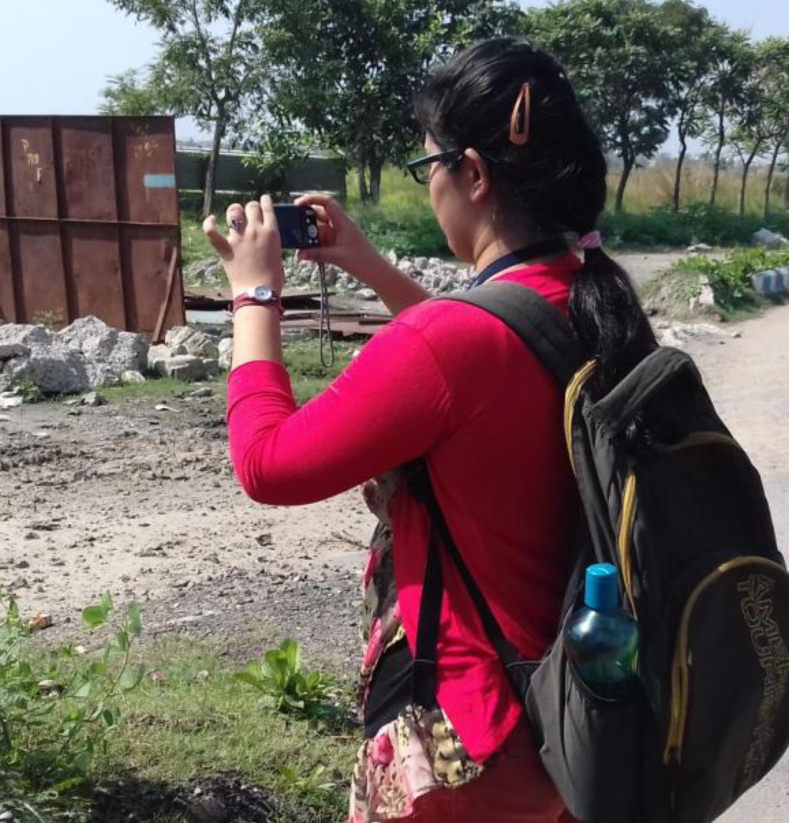
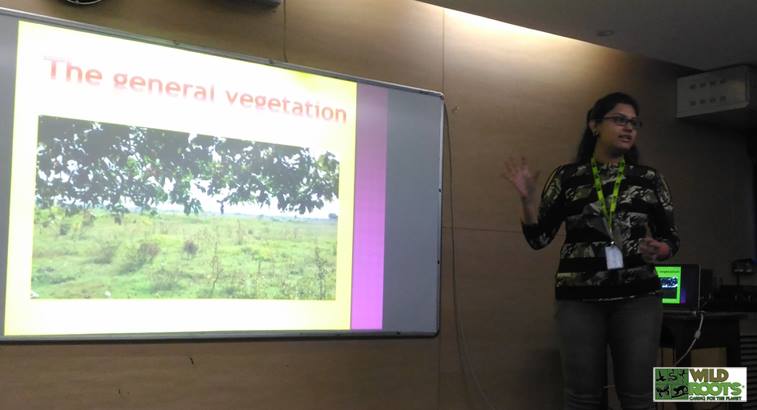
Swarnali during the field study at Rajarhat and giving a Reflective Presentation on her Learning Outcomes at her College. Thanking You WildRoots! Swarnali Chatterjee Student, Shri Shikshayatan College, Kolkata, West Bengal |
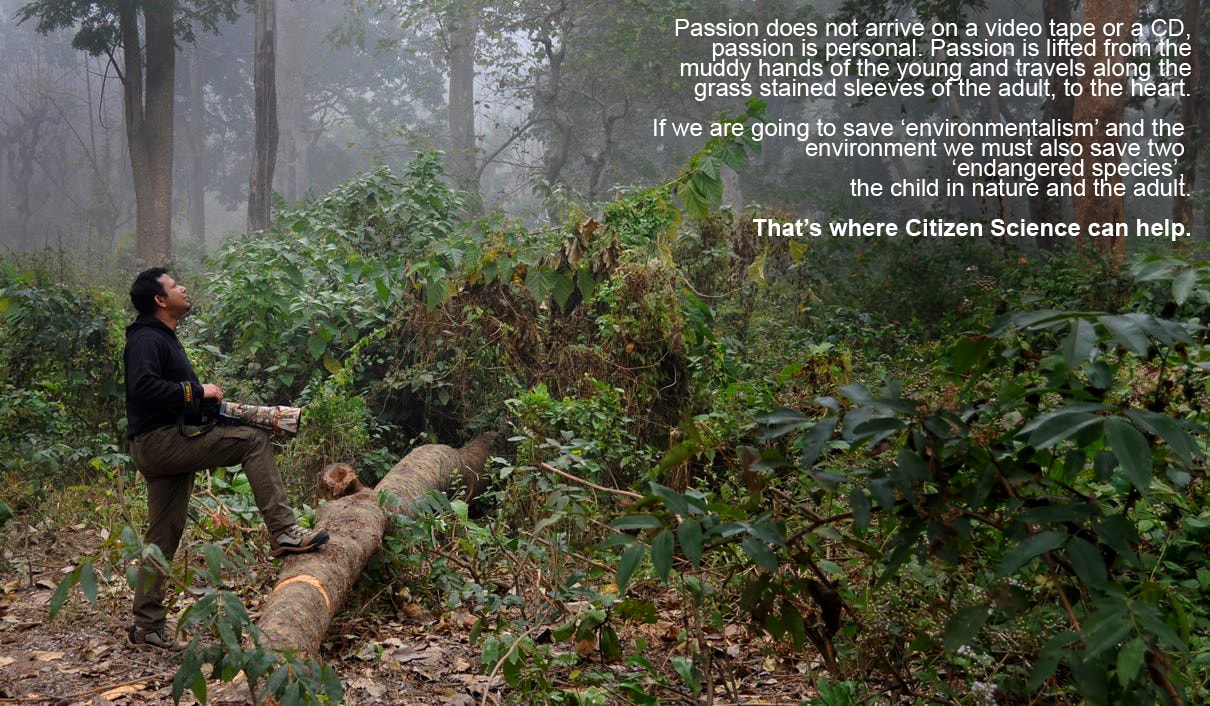 No matter your passion— butterflies, mushrooms, birds, reptiles, amphibians or ‘all life on Earth’—there is a ‘Citizen Science’ project that needs your help to thrive. Citizen science, also called Public Participation in Scientific Research (PPSR), has always been around, but during the last 5 to 10 years it has taken off with a new generation of participants, tools, Internet resources, and Mobile devices. This is especially true of species inventories which focus on counting the number of organisms found in a particular geographic region over a defined amount of time: for example, 12 or 24 hours. Over the last few hundred years, people who were not professional scientists, but were interested in natural history, collected and shared observations and descriptions of nature that formed a baseline or starting point of information that helped to better define and understand the living world. As time went on, new information was added to this body of knowledge, and comparisons and hypotheses or predictions about what might happen under certain conditions were made. Natural historians had excellent observational and recording skills. Through this “patient interrogation of a landscape” they gathered all kinds of information about individual species; the growth, behavior and interactions of plants and animals; the phenology or life cycle and timing of animal migrations; plants flowering; and much more. As the scientific method developed, more experiments and analyses were performed, generating new knowledge about how the natural world works as well as the number and role of the organisms or species that inhabit it. If it weren’t for the help of nonprofessional scientists, or the ‘lesser experts’ (you might call them) data collection, analysis, and the contribution of knowledge about the living world would have been extremely slow. The same is true today. The same forms the basic foundation of Citizen Science. Currently, Citizen Science (or PPSR) continues to involve people of all ages, skills and interests directly in a variety of scientific projects and activities. Anyone can be involved and make meaningful contributions. It simply takes a desire to learn and a willingness to get involved in a project. Many projects are also taking advantage of technologies such as the Internet and Mobile devices. These tools create flexibility around when and how someone participates in a project and they allow people to work collaboratively on projects without being constrained by having to meet with an individual or group at a defined time and place. The benefits of PPSR projects range from creating public awareness and understanding of scientific concepts to fostering scientific skills including observation, recording, measuring, and analysis. It can be easily understood that one really doesn’t have to be an expert, with all due respect to the wonderful academicians, scientists and naturalists that inspire us every day, to participate in such observation based activities that primarily help to connect people with Nature. Another very important outcome is that PPSR projects can provide real contributions to scientific research, benefiting both the scientific community and society. The natural world is full of questions whose answers require a PPSR approach. The number of published scientific papers based on citizen-collected data is increasing each year. Many more projects could be created that will appeal to the increasing numbers of amateur naturalists and stargazers who are interested in lending their brains to science. ‘You don't need a Ph.D. to contribute to Citizen Science scientific research. Thanks to the proliferation of mobile apps and advances in online crowdsourcing platforms, non-professionals are helping researchers identify new species, track comets, name proteins, project climate patterns and much more. Science-minded individuals have myriad opportunities to get their hands dirty and partner with professional scientists, conducting ground-breaking research together. Matching your interests and skills with projects: Ok…do you like to take photographs of nature and share them over the Internet or via your smart phone? Or would you prefer to help a scientist collect data for a global plant monitoring effort? Perhaps you want to join a team of people at an upcoming field survey taking place somewhere in the world? There are a very large number of international Citizen Science projects from which to choose. Several helpful websites and resources are listed at the end of this article. But before investigating those specific options, let me take a minute to review the different types or levels of projects that are available. Please remember that I have collected this information from Online Sources or from Publications and Books. We at WildRoots, India conducted an analysis of existing PPSR projects and programs, which vary in the extent to which the public is involved in different aspects of a scientific investigation—from data collection to defining a question for study. The report identifies three project types: • Contributory projects designed by scientists, with participants involved primarily in collecting samples and recording data • Collaborative projects in which the public is also involved in analyzing data, refining project design, and disseminating findings • Co-created projects are designed by scientists and members of the public working together and at least some of the public participants are involved in all aspects of the work. Examples of citizen science websites: There are hundreds, perhaps thousands, of Citizen Science websites around the world. This is a sample list to get you started on some explorations. Check out these really cool websites. (If you have a site we should know about, please Contact Us) o EOL Citizen Science Projects Collection http://eol.org/collections/29226 o Citizen Science Alliance www.citizensciencealliance.org/ o Citizen Science Central www.birds.cornell.edu/citscitoolkit o CitSci.org http://citsci.org o Citizen Science Quarterly http://citizensciencequarterly.com/ o iNaturalist http://www.inaturalist.org/ o iSpot http://www.ispot.org.uk/ o Journey North http://www.learner.org/jnorth/tulip/index.html o Mushroom Observer http://mushroomobserver.org/ o National Geographic Society http://www.nationalgeographic.com/explorers/projects/bioblitz/ o Observado http://observado.org/index.php o Project Budburst http://neoninc.org/budburst/ o Project Noah http://www.projectnoah.org/ o SciStarter.org http://www.scistarter.com/ Let me share the story of Project Noah - Project Noah founder Yasser Ansari (he calls himself the "Chief Leaf") likes to think of his organization as the most hospitable starting point for amateur taxonomists and anyone curious about things they see in nature. The four-year-old project — which is affiliated with National Geographic and has iPhone and Android apps, as well as an online hub — allows users to report and record species sightings, track their movements and pose questions to professional scientists and other community members. Since 2010, Project Noah’s more than 250,000 users uploaded more than one million ‘geotagged’ photos from all seven continents. Some of those photos generated major ecological investigations. Project Noah users have, for instance, captured evidence of what some believe to be the first documented cases of an Ant Mimic or Ground Sac Spider in California and a Three-Striped Red Crab Spider in Sri Lanka. This is indeed BIG! Both discoveries have entomologists buzzing, and they prove that Citizen Science means more than just silent observation. "Every schoolyard and backyard has the potential to become a biological research station and help us learn more about our planet," Ansari says. I really feel that the next Attenborough or Goodall could already be part of our community, and it's up to us to keep encouraging him/her and pushing him/her forward. Needless to say, before designing the Citizen Science programmes and projects for WildRoots, we have though roughly studied the above websites and Citizen Science Organizations. No harm in being honest, isn’t it? Well, most people will not declare this fact. There is no harm in learning new strategies and action plans from people and organizations that have had enough success stories. They form the foundation of a successful Citizen Science Programme. The most prominent essence of Citizen Science Programmes is the fact that it helps people connect and identify with nature. So, our point is, if you have a certain skill, you can also be a part of a Citizen Science Programme anywhere in this world. Maybe your involvement won’t transform you into a scientist, but your contribution would enable someone do their research, or find out a new species, if you are lucky enough. -Biswajit De, Founder President, WildRoots, India |
 Birding in the mudflats of Chandrapur, Guwahati, Assam around this time of the year becomes quite an interesting activity, as the entire area gets converted into numerous 'micro habitats' - an arrangement of wetlands, small puddles to large ponds, small stretches of grasslands to sandy banks, after the water from the river recedes just after the winter season. The silt deposits make the soil fertile, giving opportunities to new ‘life’ to sprout.  
  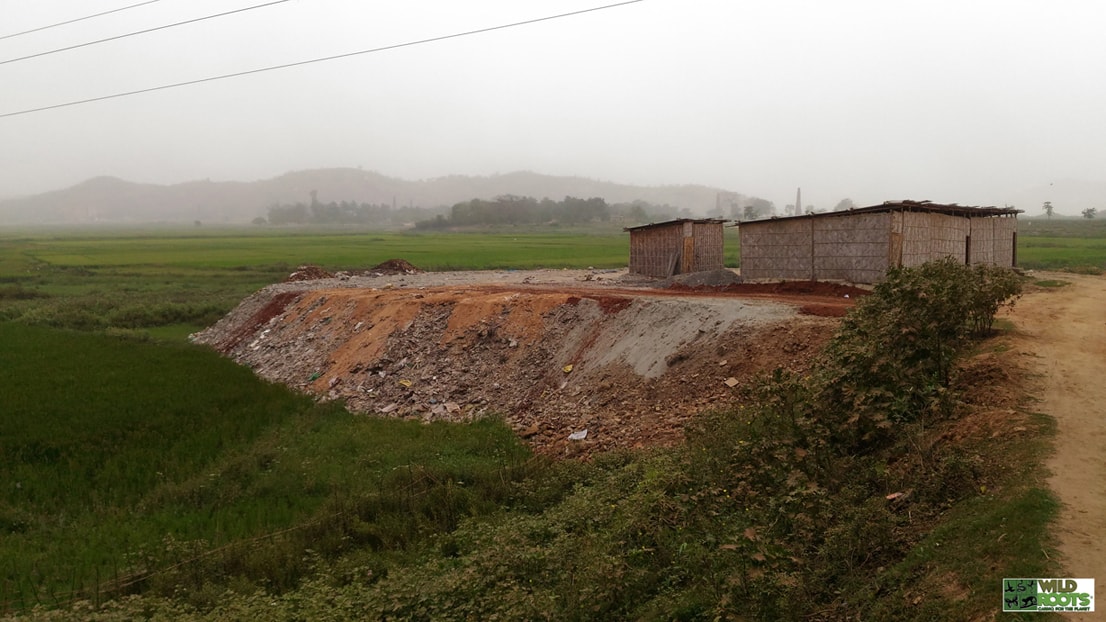 - Uncontrolled landfills are a constant threat to grassland and wetland habitats By observing the avian activity at the path, season by season and year by year, one can discover that some individual birds migrate away for the winter and then come back to exactly the same breeding territory, every year. Such a species is the Bank Myna – (Acridotheres ginginianus), which have a nesting season from April to July or August, most birds breeding in May and June. The nest is always built in earth walls, on the banks of the river Brahmaputra. It was great to find and observe the nests of these Birds at Chandrapur, but care was taken not to disturb them much, as they get really alert, as anyone approaches the nesting areas. This is where long telephoto lenses come handy. I was able to grab a few shots of the nests and the birds, from far away, before leaving the area, as soon as I could. -min.jpg) 1. The Bank Myna and the nests that I found. -min.jpg) 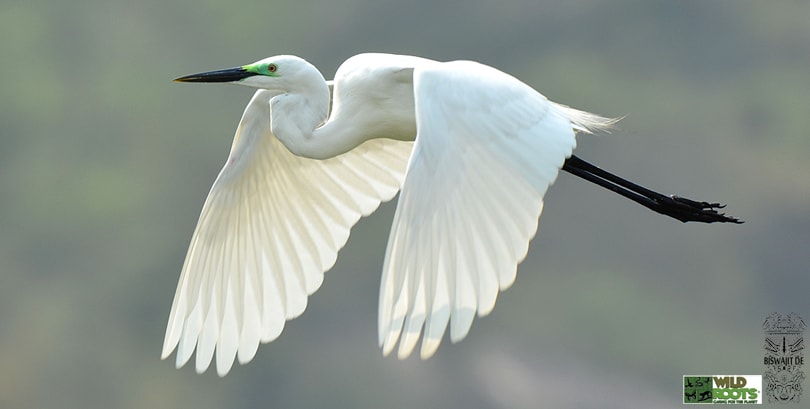 2. Intermediate Egret (Ardea intermedia). 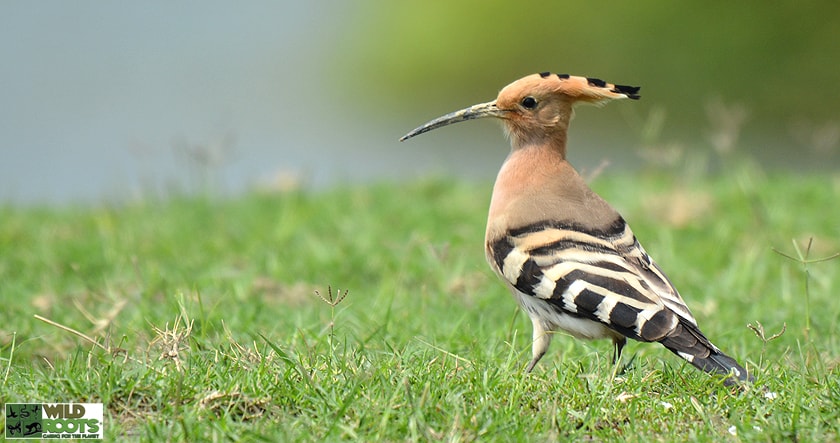 3. Common Hoopoe (Upupa epops).   4. Common Sandpiper (Actitis hypoleucos).  Foraging habitat of the Common Sandpiper (Actitis hypoleucos). The weather wasn't too hot today, the sun soothing enough not to make me sweat, comfortable observations at the mudflats made a perfect start to the 'Bengali New Year' and added to the celebration of the 'Rongali Bihu' festival of Assam. The feathery friends connected much more than the States...I would say.  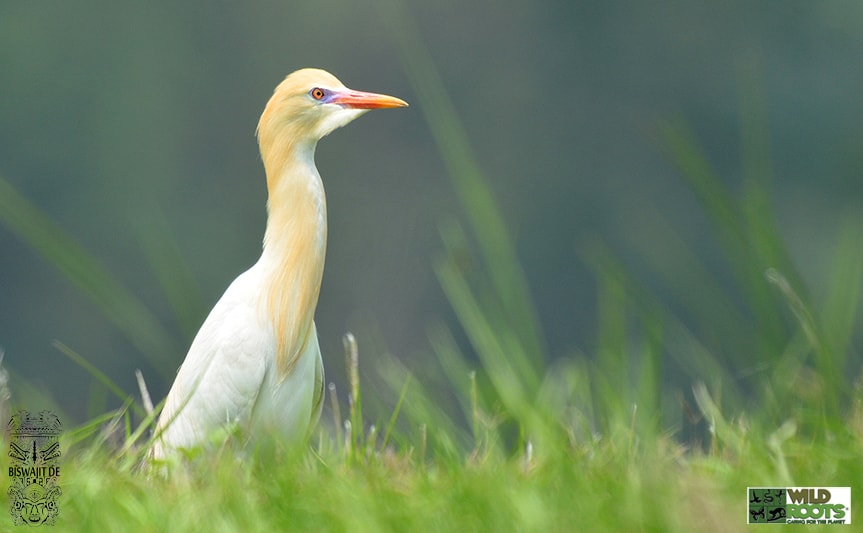 5. Red-wattled Lapwing (Vanellus indicus) & 6. Cattle Egret (Bubulcus ibis)-In Breeding Plumage 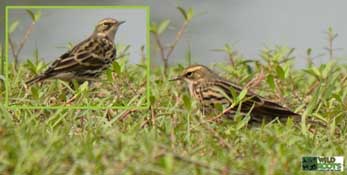 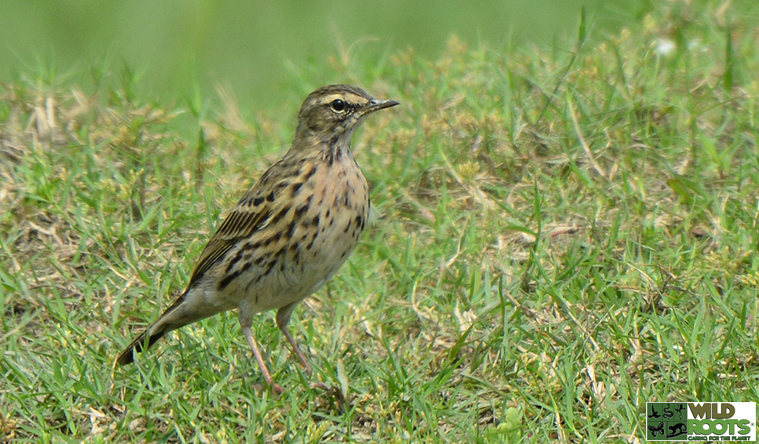 7. Rosy Pipit (Anthus roseatus) 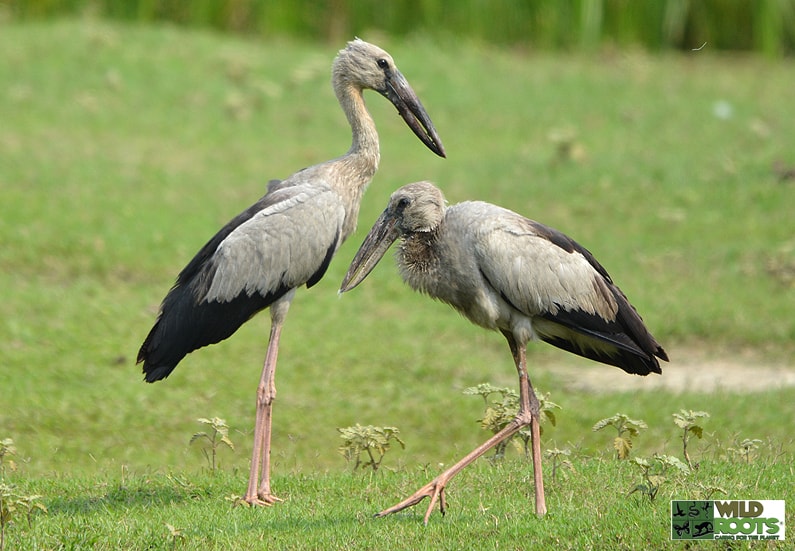 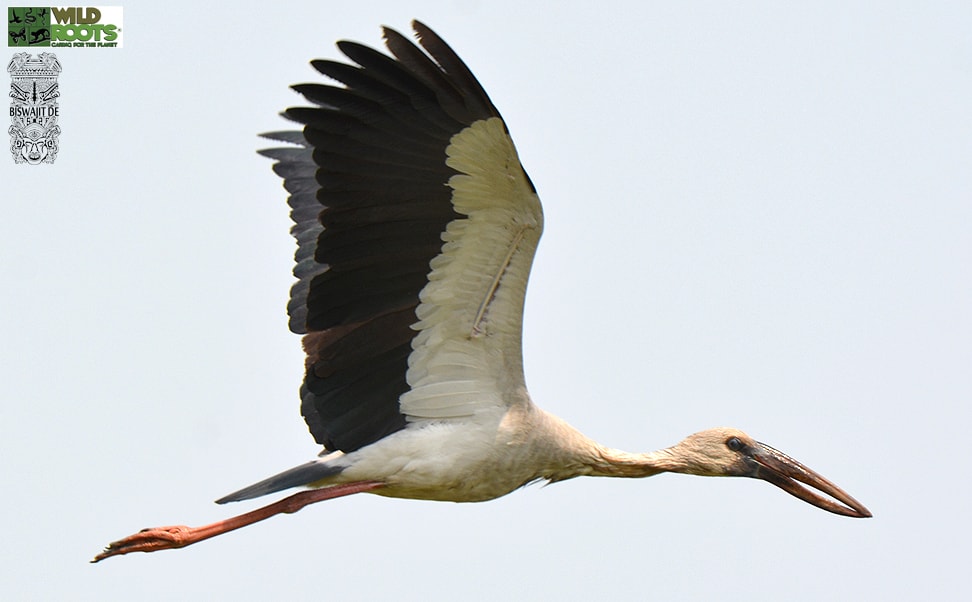 8. Asian Openbill or the Openbill Stork (Anastomus oscitans) 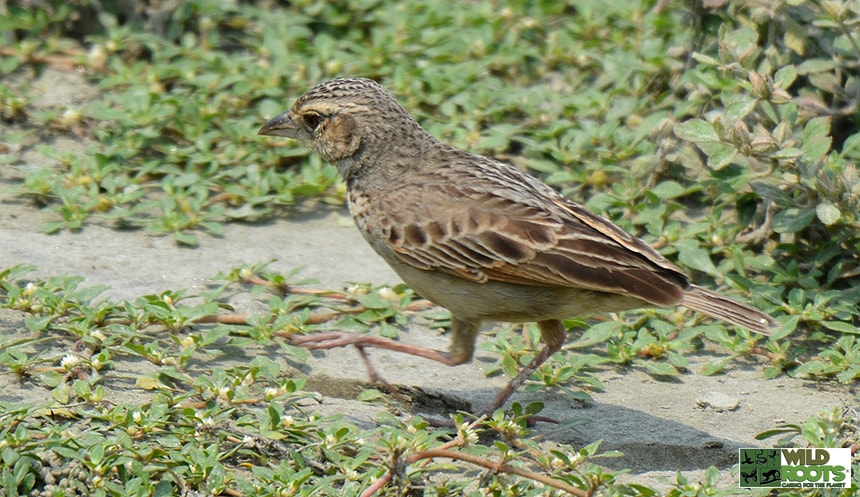 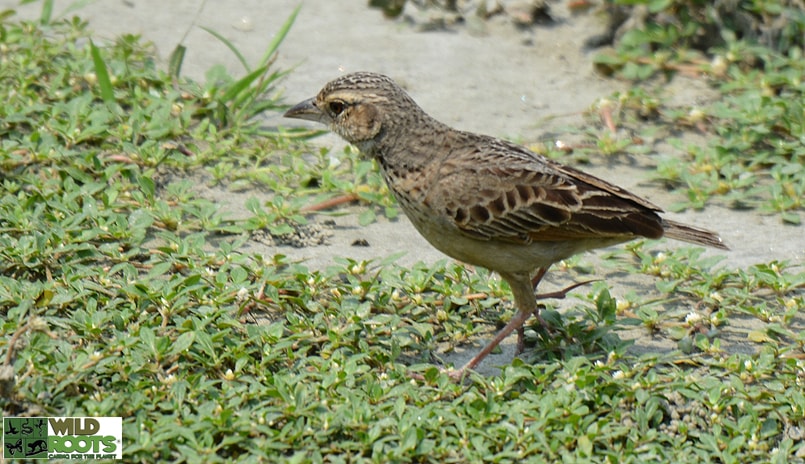 9. Bengal Bushlark (Mirafra assamica) 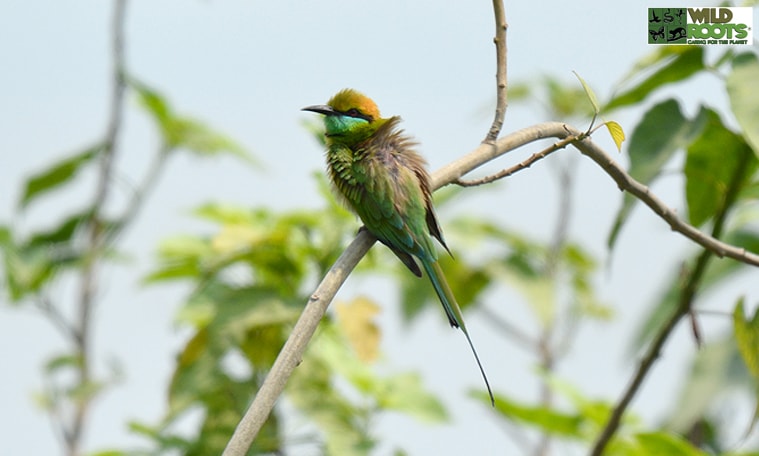 10. Green Bee-eater (Merops orientalis) 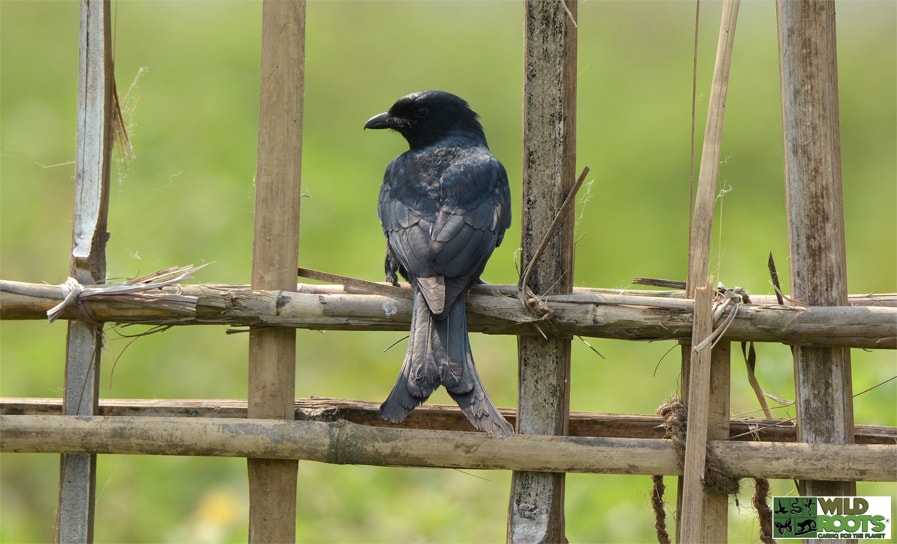 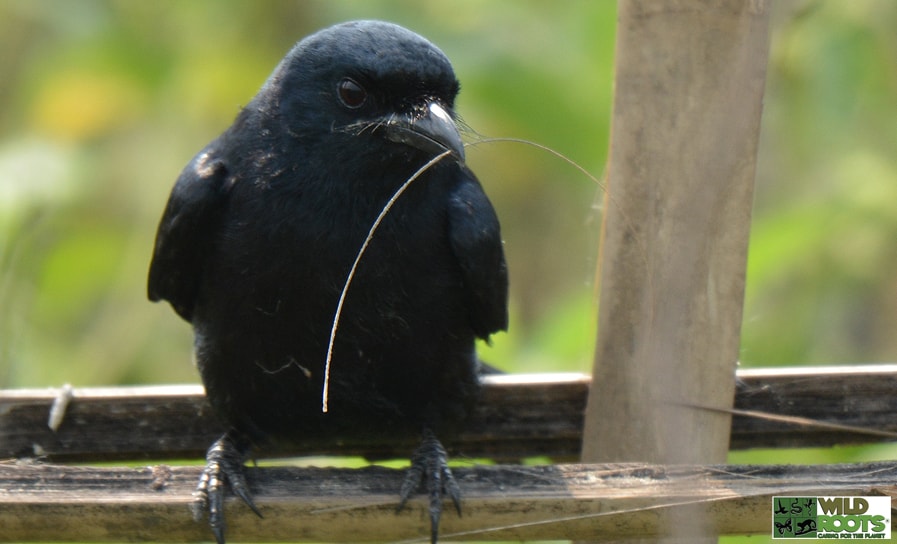 11. Black Drongo (Dicrurus macrocercus)   12. Red-collared Dove (Streptopelia tranquebarica) & 13. Eurasian-collared Dove (Streptopelia decaocto) *The complete checklist of birds spotted on April 15th, 2017 can be found at: http://ebird.org/ebird/view/checklist/S35999770 Chandrapur Mudflats, Darrang, Assam, IN Apr 15, 2017 7:00 AM - 10:20 AM Protocol: Traveling 3.0 kilometer(s) Comments: WildRoots - Biswajit De: Observing Birds in a favourite patch. 22 species Asian Openbill 5 Little Cormorant 2 Intermediate Egret 2 Cattle Egret 15 Indian Pond-Heron 4 Red-wattled Lapwing 2 Common Sandpiper 2 Eurasian Collared-Dove 1 Red Collared-Dove 2 Spotted Dove 10 Eurasian Hoopoe 1 Green Bee-eater 2 Black Drongo 2 Bengal Bushlark 2 Striated Grassbird 5 Common Myna 25 Bank Myna 50 Citrine Wagtail 10 White Wagtail 1 Paddyfield Pipit 5 Rosy Pipit 3 Eurasian Tree Sparrow 10by Biswajit De, Founder President, WildRoots |
 Photo: Walker Golder Don’t bother asking me if I’m more of a birder or a photographer. I’ll just lie and tell you I find both topics “kind of boring.” It’s my clever smokescreen for completely sidestepping the birder/photographer rivalry. I prefer to identify as bird-activity neutral. I came to love both birds and cameras in a roundabout way, so I’ve always felt like something of a misfit. I got my start practicing the fine art of being a beach bum, taking pictures just to see the beaches I love in more detail, and studying the birds because they lived on those beaches and I was jealous of them. Back then, I didn’t even know there was such a thing as a birder and had never met a wildlife photographer. But that all changed in the winter of 2013 when 14 Snowy Owls showed up on my beach and scores of birders and photographers followed. Beach bumming is a lonely business, so I spent much of that winter giving them rides out to the owls in my Jeep. I learned so much from so many smart people during those rides. But more than anything, I discovered just how much birders and photographers detest one another, and how much I admire them both. I kept my mouth shut as each launched into a tirade about the other’s despicable behavior and how it leads to the demise of birds. All of my newfound friends were insulting my other newfound friends. I felt like I had to choose a side. While listening to so many rants that winter, there were a few things that kept catching my attention. The first was that at the heart of the rivalry, these groups did not fundamentally respect the value of each other’s activities. The second was that they did not properly account for the very different ethical implications of those activities. The third was that the failure to resolve those first two things is silly and bad for the birds. A few years later, after continually deeper immersion into bird culture, I’m more convinced than ever we should put this rivalry to bed so we can regroup, fix more problems, have more fun, and help more birds. Let’s Just Say We’re Both Valuable And Leave It At That Common refrains in the rivalry are such gems as “that birder is trespassing just to check a bird off a list” or “those photographers are terrifying that bird just to get more likes on Facebook.” It’s time to stop disparaging two of the world’s finest activities with simple generalizations that misrepresent the value of both activities and the motivations of the good people pursuing them. That both birding and photography are incalculably valuable to the world is a given. Beneath many an angry rant is a weak foundation that lulls us into thinking “everything would be better if only [birders/photographers] would stop doing their activity.” The truth is everything would be worse. Not only are bird observation and bird photography magnificently worthwhile in their own right, they round each other out and create one of the most powerful citizen science groups on the planet. But Let’s Recognize Our Differences Too If we can agree that both activities are valuable, we can then get to the true heart of the rivalry: the simple reality that the ethical risks and requirements of birding and photography are completely different. Birders have always had the ethical upper hand, thanks to the fact that birding allows them to stay farther away from a subject. For birders with good optics, healthy distance risks no disruption to the birds and leads to higher-quality observation. The wide perspective also allows birders to see more of what is happening in the field. This often puts them in the unfortunate position of policing others. Photographers are at a relative disadvantage. Even the $10,000, state-of-the-art, professional long lenses available today don't have the technical ability to keep photographers out of the risk zone. They must get closer to birds and stay with them longer, and so the ethical burden is much greater. This often puts them in the unfortunate position of being more likely to do something harmful. These differences sound comically obvious, yet they too often are overlooked. Photographers accuse birders of being uptight and bossy, ignoring the reality that many birders are more likely to witness bad behavior. Honest photographers who want to master their craft should welcome birders watching from a distance. They have the better vantage point. Birders on the other hand are too quick to say photographers don’t need to approach wild animals at all. But those birders don’t understand the subtleties and technical requirements of photography. They can also be quick to underestimate just how valuable photography is to the future of birds and how close you can actually get without disturbing them. There’s More Power in Joining Forces Birders and photographers are like two departments of a larger company. That company’s job is to squash ignorance and apathy as they relate to birds and the wild places they live. By focusing on that common mission, we can team up and create a better internal culture to squash problems in our own workplace—ones like trespassing, disturbance, and carelessness. Every photographer who is serious about helping wildlife could benefit by spending more time with birders. Photographers can learn a lot by stepping back and observing subjects from afar. And every birder who is serious about helping wildlife should join a photographer on a close approach and a long sit with a bird. With a better understanding of the value of each other’s activities, and the unique risks and responsibilities of each, we can start helping each other to help more birds. And now I have to go. My inbox is already filling up with emails from every birder I know saying this article was too soft on photographers, and every photographer arguing it was too soft on birders. *Jim Verhagen is a self-described beach bum with a camera from Long Beach Island, New Jersey. He strongly believes that coastal wildlife is the undervalued crown jewel of the Jersey Shore and works tirelessly to get more people to agree with him. |
Velavadar National Parkformerly the private grassland of the Maharaja of
Bhavnagar,is one of the most beautiful grasslandstodayfor the ‘blackbuck’ to
inhabit. Created in 1976, it nearly doubled in size in 1980; the park now covers 34
square km, which is barely one-sixth the size of the city of Ahmedabad. Over 10
square km is made up of saline lands and high tidal mudflats. These mudflats are
the high tide zone of the Gulf of Khambhat, and the lower part of the park (not
just the tidal area) also floods every so often.
 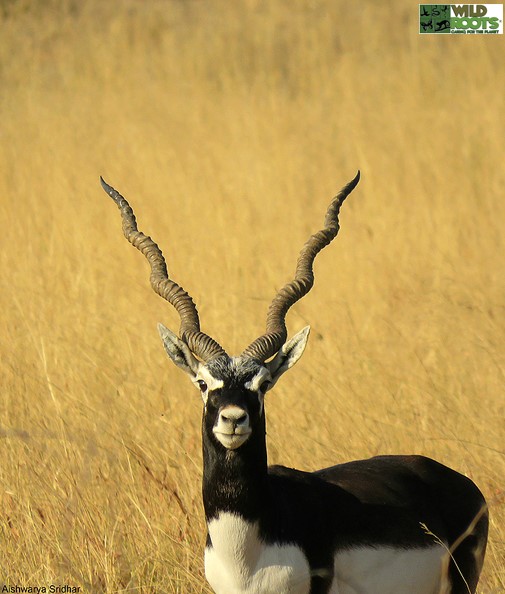
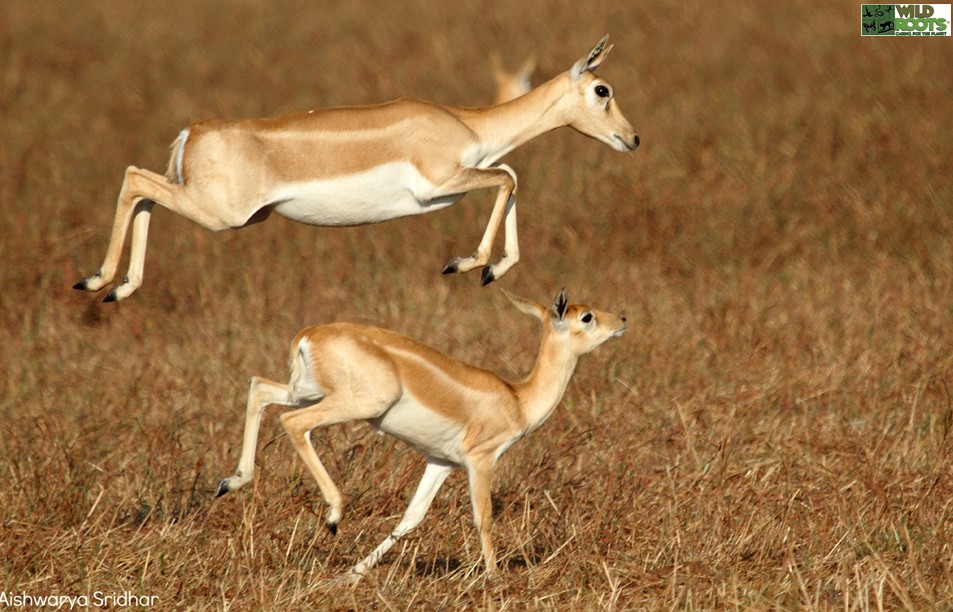 The blackbuck, for which the park was created, lives mostly in the grasslands on the northern side. Found only in South Asia, the blackbuck once lived all across India, but now the largest population is here, and few are found outside Gujarat. The conservation of the blackbuck here has been a big success, however, it remains endangered due to its dependence on such a limited area to live in, but the local population has risen from a low of 200 in 1966 to around 4500 now. Given such a large population in such a small area, the chances of spotting one are very high, especially since the wide open grasslands make it easy to spot these animals leaping high over the grasses. The breeding seasons are October and February. 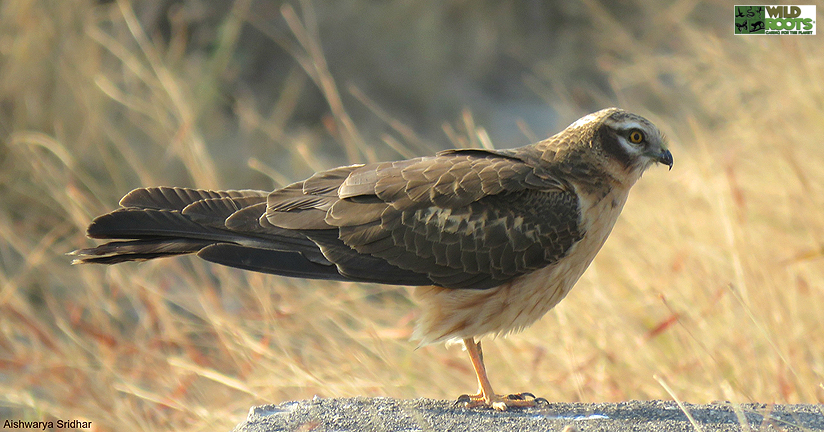
Other animals in the sanctuary include the Nilgai (another Indian antelope), jackal, wolf, jungle cat, and fox, but the other main attraction is the bird life. Pelicans, flamingos, white and painted storks, three kinds of cranes, many birds of prey, and the rare Stoliczka'sbushchatall live here, mostly in the southern part of the park, where all the wetlands lie. The extremely rare Lesser Florican, one of the 50 rarest birds in the world, breeds here. In the winter, thousands of harriers arrive from central Europe to spend the cooler months here; you can see them in the evenings coming back from feeding around the neighboring cotton fields. One in particular, the Montagu’s Harrier, is a major predator of the locust, a great problem for farms all around the area; as a safe haven for the pest-controlling harriers, the park serves an important role in local agriculture. But while the national park is essential as a core which provides strict protection, the surrounds are equally crucial for all its denizens. There is little doubt that Velavadar has incredible biodiversity value, and merits the strictest protection. But those in charge have shown scant regard with disastrous development projects planned in the immediate vicinity of the park. The plans to expand the state highway which will cut through the park will deal a severe blow to its bio diversity. The road will cause further disturbance and more accidents to blackbucks, jungle cats and wolves that already face the threat of extinction. A graver threat — a senior forest officer called it a “death knell’ for the park is the mega-development plan in the Bhal-as this region is called locally. A Special Economic Investment region is coming up bordering the park, and the land proposed to be acquired includes villages Bavaryali, Adhelai and Kanatalav are part of the proposed eco-sensitive zone. The investment region will bring about ancillary development-already on the proposed list is an airport, port and a thermal power plant.Most of the lesser floricans nest in the adjoining wastelands, grazing lands and fields, the harriers feed outside the park too-on locusts, insects and other pests, and thus are of huge benefit to the farmers. The Bhal region is one of the few last strongholds of the wolves. All this may no longer exist if the development plans are carried out. 
Local villagers stated that last year climate changes led to deficit monsoon and the population of harriers has seen such a dip that sightings have been reduced to just a few ….the insect life has become zero due to lack of rains and grass cutting and weeding have further increased the human presence in the park thereby forcing the hyenas and wolves to seek other areas for shelter. The black buck population has somewhat remained steady amidst all this. How to get there By road: Lodging is available at the park headquarters, but reservations are necessary. Call BahumaliBhavan, in Bhavnagar (Tel: 0278 242 6425, between 10:30am and 6pm), or call the park directly at Tel: 0278 288 0342. The nearest town, Valabhaipur, is 32 km away, and Ahmedabad 145 km away. If you come by private vehicle, the Black Buck National Park is entered from Valabhaipur on the old highway or Adhelai on the Bhavnagar-Ahmedabad highway. Otherwise, the park is accessed by bus from Bhavnagar (72 km away). Two buses travel daily between Bhavnagar and the park; leaving the city at 2 or 3:30pm and returning from the park at 6 or 6:30am the next morning. For a day trip you will need your own vehicle; taxis can be hired in Bhavnagar for Rs. 700-1000 per day. By rail: Bhavnagar is the nearest railhead, connected by trains from Mumbai. Another railway station is at Dhala: 55 km away, but there is no regular public transportation from there to the park. By air: Bhavnagar is the nearest airport. Mumbai is connected to Bhavnagar through domestic flights. Be sure to book in advance as not many flights are available. by Aishwarya Sridhar Content Developer & Life Member, WildRoots, India *All Photographs accompanying this article are copyrighted to Aishwarya Sridhar. |
 Photographer James Balog and his team were examining a glacier when their cameras caught something out of the ordinary.The incident took place in Greenland, where James and his mates were gathering images from cameras that had been deployed around the Arctic Circle over the years.James and his crew were looking for some good shots for an upcoming documentary, but no one was prepared for what would soon unfold in front of their eyes. Even though American photographer James Balog specializes in nature photography, for a long time, he didn't believe in climate change.  The historic event has been recorded in the Guinness Book of Records and clearly shows how serious the situation is for Earth's climate. As far as anyone knows, it was an unprecedented geological disaster. Unfortunately, though, it's unlikely to be the last one of its kind. Watch the powerful video here: https://youtu.be/hC3VTgIPoGU In November 2016, the Arctic was 20 degrees warmer than average, which is much warmer than even research models had predicted. Unfortunately, we're faced with disaster if we don't zero our global greenhouse emissions by 2070. But on the positive side, we still have a chance to make that happen. Hopefully, this video will help convince more people of how serious the situation is, so that together we can help to reverse the trend! No one can do everything, but everyone can do something. Please share! Related Article: https://www.theguardian.com/environment/2016/nov/22/extraordinarily-hot-arctic-temperatures-alarm-scientists |
 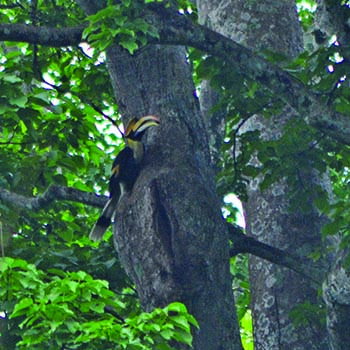 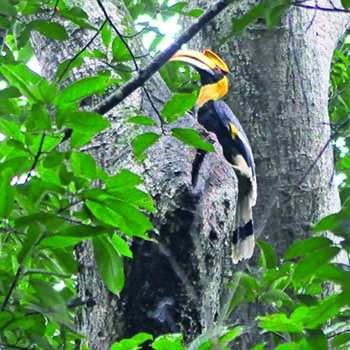 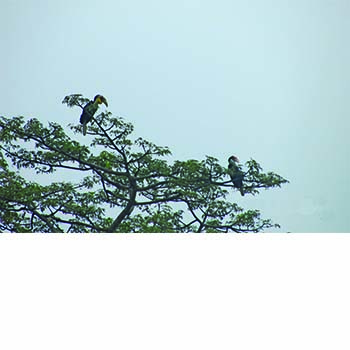 |
The watch showed 3:30am as our bike sped its way amidst the darkness, to the west bank camp, a slight drizzle continuously lashing out at us. The Pakke River was in all it’s fury, raging below us as we crossed the bridge. A hare quickly ran to the grassy patches next to the road, while a startled Asian Barred owlet took off from a small tree where it was perched. We reached the forest gate, parked the bike, and me and Turuk made our way to the site. Having set the temporary shelter, digi-scopes and binocs, we waited. Why, you ask? Because very soon, a faint ‘whoosh-whoosh’ sound of wing beat, gradually increasing in intensity, was heard, and soon, the male of the great hornbill came and perched on the nest, calmly feeding the female sealed inside with fruits it picked up earlier, while I noted down the data I had come to collect!
Seijosa village: Seijosa is the entry point to Pakke tiger reserve, situated in the border of Assam and Arunachal Pradesh. It is a small village sandwiched between the Pakke Tiger reserve and the Pakke river on one side, and the Papum Reserve Forest on the other. I was in Pakke for a month, volunteering with NCF in their hornbill research and conservation project. The first thing I noticed on arriving in Seijosa was the lush greenery and the clean and cold air which I found to be a huge respite from the polluted air of Delhi! Our camp was situated in a very beautiful area, with paddy fields all around us, a small hill right in front of the house, and the higher mountains of Arunachal clearly visible. The rain was highly unpredictable, but you can see as well as hear it coming your way, which in a way, gives one enough time to take shelter! To a novice like me, though, it took time before I could get the hang of such an unpredictable weather, and in almost all of the occasion, I came home drenched to the core! As a volunteer, my main work was to visit 4 designated hornbill nests, and watch them for a few hours, and collect the relevant data, like the number of times the male visited, the food item fed, etc. To a person like me, having to sit in one place for so long was an immensely tough prospect, owing to my impatient nature. But all the exhaustion would soon vanish when I would finally set my eyes on the hornbill which would come flying from far off, collecting food from various trees, only for its better half! And being in the forest for so long always guaranteed the sightings of many more than just hornbills. In the evening, we would go in the river bank to observe a roosting tree of a wreathed hornbill. Every day, like routine, flocks of wreathed hornbills would come flying to this tree, and perch on the various branches and preen them. It was a sight to behold as the birds arrived, individually or as pairs, on the tree, and the total count would go well above 30 individuals! This was the perfect way to wrap up the day. The hornbills of Pakke 4 species of hornbills occur in Pakke- great hornbill, wreathed hornbill, oriental pied hornbill, and the rufous necked hornbill. While the former three are common in Pakke, the rufous necked is found only in the higher elevations. Hornbills act as a seed disperser, earning them the name “farmers of the forest.” The hornbills make their nest in tree cavities, which can either be created by other birds like woodpeckers or barbets, or due to falling off of a branch, leaving behind a cavity. Nesting season is between May-August, during which the female seals itself inside the cavity, and lays an egg, while the male comes and feeds it from a small slit left on the cavity entry. In the month of july, the chick comes out of the nest, after which it takes its first flying lessons, often in the careful supervision of its parents. The people of Pakke: The highlight of my month long sojourn was, however, the opportunity to live alongside the local people of Pakke. Most of the locals belong to the Nyishi community, a traditional, self sustaining tribal group, limited to some parts of Arunachal Pradesh. What amazed me the most was their incredible sense of awareness, responsibility, and pride towards the wildlife that live around them, especially the hornbills (also called paga, and pooh). From a group of hunters living and maintaining their tradition primarily from hunting the wildlife, these people are now the true guardians of Pakke, and why not? They know it very well that the hornbill, and the other wildlife, gives them, and Pakke, an identity. They never want to poison the elephants which ravage their farmlands; neither do they want to mob down the tiger which would occasionally pick on their cattle. All they want, and that is how I understood them, is a space where both human and wildlife can live in harmony! And after the advent of the forest department, NCF, WTI and other organizations, the people of Pakke have involved themselves wholeheartedly for the cause of their rich heritage. As a volunteer, I had to visit the forest with either Turuk, or Talle, both highly dedicated local field staffs with NCF. It was a privilege to walk the forests with them, as they knew so much about it and its residents, and walked around the forests with such ease, that it was difficult to keep pace with them. Inspite of that, they always waited for me to catch up with them. From collecting forest mushrooms(laafu) for lunch, to showing me various signs and tracks of animals, to proudly talking of their various adventures in the forest, they always were eager to talk and teach the novice accompanying them, something new. One afternoon, while we were monitoring a wreathed hornbill nest, I and turuk were sitting under our makeshift tent. It was a hot afternoon, and we both sat, waiting for the male hornbill to come, when all of a sudden, there came a rustle from somewhere in front, and no sooner did we wonder what it was, a huge elephant came into view just a few meters from us! Without haste, we quickly vacated that area, and waited for it to pass by. I could hear my heart throbbing as I stood there, waiting for the gentle giant to leave the area, before we could clear off from his home. Never have I felt such a sense of exhilaration and fear before, but as Turuk later said, the forest will make sure I get many more such moments! Now, as I sit in the comforts of my home, typing this out, my mind wanders off to a lovely evening in the banks of the river Pakke, where I counted the arrival of 78 wreathed hornbills, observed a herd of elephants drink water from the cool waters of the river, and watched as the sun set off, creating a beautiful vista with the clouds and the hills, only to shine its first rays on a yet another wonderful day in Pakke. by Sutirtha Lahiri Assistant Secretary, WILDROOTS, India Email id- sutirtha1996@gmail.com |
|---|
|
Click here to read the paper
Dear Wildroots Members, Happy to share this new publication out in Indian BIRDS journal. In this paper, I talk about the seasonality, distribution and movement of the 2 species of cochoas in India. I used a combination of eBird records, old literature and museum specimens (from British Museum, Smithsonian, AMNH, UMMZ, BNHS etc) to find out more about the species. I find evidence that contrary to other belief, the cochoa is a resident species, found in much of North-east India, particularly in Arunachal Pradesh. I also provide evidence of how the cochoas are probably tracking food resources and thus moving sporadically. This is of particular interest as I found a purple cochoa at Dehing Patkai at 200msl, the lowest record for this species anywhere in its range! In this paper, I share authorship with my field assistant, Bablu Sonowal, who made the sighting. I am delighted to give him a platform and also recognize his contribution more formally, and hope that more and more researchers make efforts to similarly acknowledge the people they work with, especially their local assistants and collaborators. Hope you enjoy reading this. - Sutirtha Lahiri, Secretary, WildRoots-India. https://sutirthalahiri.wordpress.com/ |